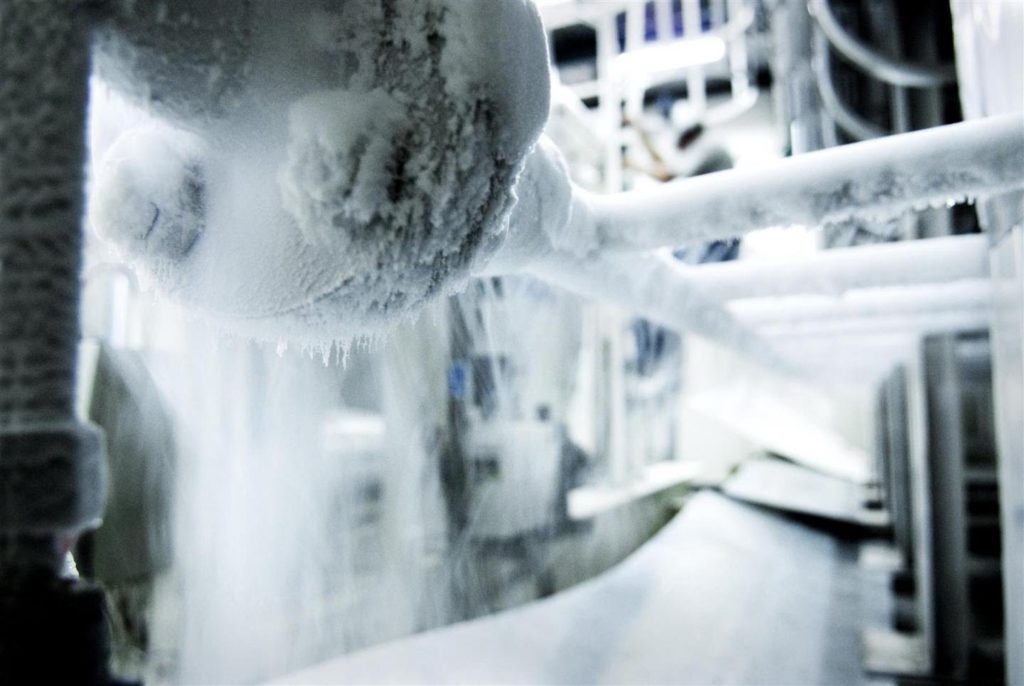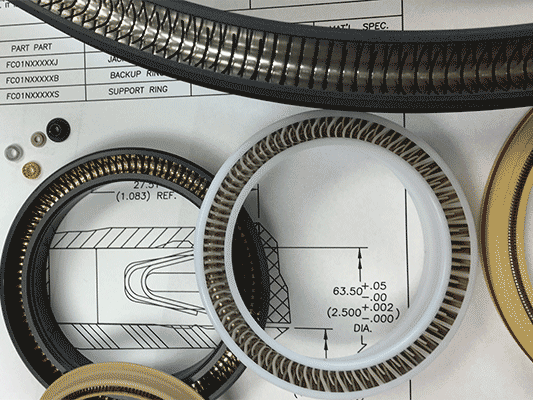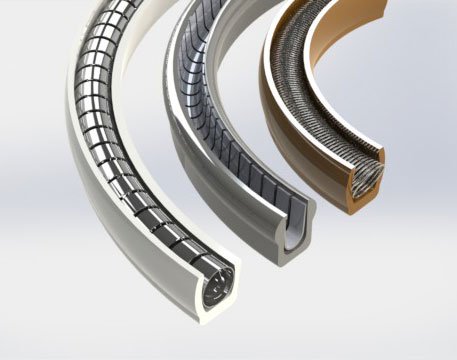Seals for cryogenic space applications must survive conditions that push materials and engineering itself to the edge. Temperatures can drop below -250°C. There’s no atmospheric pressure. No lubrication. No margin for error. And when these seals are used in systems like cryogenic fuel transfer, attitude control thrusters, or deep-space instruments, failure isn’t just inconvenient: it’s catastrophic.
That is where PTFE spring-energized seals come in. These seals combine low-temperature flexibility, chemical inertness, and a constant, adaptive sealing force, making them one of the most reliable options for cryogenic sealing in space.
In this article, we break down how they work, what materials and energizers are involved, and why they outperform traditional sealing technologies in the vacuum and cold of space. We also tackle the biggest challenges in cryogenic aerospace sealing—and show how these advanced seals meet them head-on.
What Are Spring-Energized Seals?
A spring-energized seal utilizes a precision metal spring embedded within a polymer jacket (e.g., filled PTFE, PEEK, FEP) to apply a continuous force against the sealing surface, ensuring reliable, low-friction sealing even under extreme temperatures, pressure variations, and material contraction. These seals have proven ideal for some of the harshest environments, including static and dynamic cryogenic systems.
Spring energizers are available in various configurations, including cantilever for light loads and dynamic applications, helical for low temperatures and vacuum conditions, and canted coil for high-pressure, high-temperature environments.
For cryogenic PTFE spring-energized seals, the most common grades used are
- Virgin PTFE (low friction, extreme temperature tolerance)
- Glass-filled PTFE (better wear resistance)
- Carbon-filled PTFE (enhanced dimensional stability)
- MoS₂ or graphite-filled PTFE (lower wear, improved dry run)

Seals for Cryogenic Space Applications: Challenges
Engineers face several challenges when specifying cryogenic sealing solutions for space applications. These include thermal contraction, outgassing, material stability, lubrication, rapid pressure transitions, and seal life.
Challenge #1: Thermal Contraction
The extreme cold in space causes both hardware and seals to contract, with traditional elastomeric seals often shrinking and losing sealing force at cryogenic temperatures. PTFE spring-energized seals maintain contact via the spring energizer as it compensates for seal shrinkage. In fact, spring energizers adapt to radial or axial changes, maintaining sealing pressure even at temperatures as low as -250°C.
Challenge #2: Outgassing and Material Stability
Materials with a high volatile content can outgas in a vacuum, leading to the contamination of optics and electronics. However, Virgin PTFE and high-purity filled PTFE variants exhibit minimal outgassing, meeting NASA/ESA standards. They are chemically inert and stable under ultra-high vacuum (UHV) conditions.
Challenge #3: Friction and Lubrication in Vacuum
In space, the lack of atmosphere can make lubrication extremely difficult (especially if vacuum pressures are involved). PTFE is self-lubricating and has one of the lowest coefficients of friction among polymers. In addition, filled PTFE (e.g., graphite or MoS₂) enhances dry-run performance and the spring-energized design ensures low breakout friction and a consistent force profile.
Challenge #4: Rapid Pressure Transitions
Systems transitioning from launch (atmospheric) to space (vacuum) face rapid pressure differential, and traditional elastomeric seals can blow out, crack, or fail to reseat. On the other hand, spring-energized PTFE seals accommodate pressure variations with a controlled energizer preload, while the elastically deforming PTFE jacket absorbs shock without sustaining permanent damage. Additionally, options are available for high-vacuum to moderate-pressure regimes.
Challenge #5: Seal Longevity and Wear
Another serious complication when designing seals for space is that maintenance is likely not possible once a system is deployed in space. Seal wear over long mission durations can lead to leakage or mechanical failure, but PTFE’s wear resistance is enhanced through fillers (carbon, glass, bronze). And the spring maintains sealing force over millions of cycles without fatigue. Advanced EMC also provides fully characterized wear data for mission planning.
Why Choose Seals for Cryogenic Space Applications from Advanced EMC?
Advanced EMC Technologies brings deep materials science expertise and aerospace-focused engineering to the design and production of PTFE spring-energized seals, especially for extreme environments like cryogenic sealing in space.
Every mission has unique sealing requirements, and Advanced EMC offers an extensive portfolio of PTFE formulations, energizer types, and precision manufacturing options to meet them. Whether the application calls for ultra-low friction, minimal outgassing, or long-term performance under high-cycle dynamic loads, Advanced EMC engineers work closely with aerospace clients to specify the right PTFE grade—virgin, carbon-filled, glass-filled, or dry-lubricant-enhanced—and pair it with the optimal spring geometry (canted coil, helical, or cantilever) for consistent seal loading across a wide thermal range.
Advanced EMC’s cleanroom-compatible production standards, vacuum-bakeout-capable materials, and helium leak testing ensure that components meet the strict demands of satellite, propulsion, and orbital systems. These seals are not only designed to function below -250°C, but also engineered for endurance under pressure transitions, vibration, and long-duration service without re-torque or adjustment.
With an emphasis on low outgassing, dimensional precision, and thermal resilience, Advanced EMC’s spring-energized seals deliver proven reliability in systems where seal failure is not an option.
Conclusion
In the unforgiving environment of space, cryogenic sealing is not just a design challenge—it’s a mission-critical priority. Seals must withstand extreme cold, rapid pressure transitions, and the absence of lubrication, all while maintaining dimensional integrity and sealing force over long durations.
PTFE spring-energized seals provide a robust and reliable solution. With their combination of chemically inert PTFE jackets and precisely engineered metallic energizers, they provide consistent performance where traditional sealing technologies fail. Whether mitigating thermal contraction, eliminating outgassing concerns, or ensuring low-friction sealing in high-vacuum conditions, these seals deliver the reliability aerospace engineers demand.
When you need seals that perform flawlessly in cryogenic space applications, turn to the experts. Advanced EMC Technologies offers custom-engineered PTFE seals tailored to meet the highest standards of thermal, mechanical, and environmental performance. Backed by material expertise and decades of field-proven results, our sealing solutions are ready to meet the demands of your next mission.




